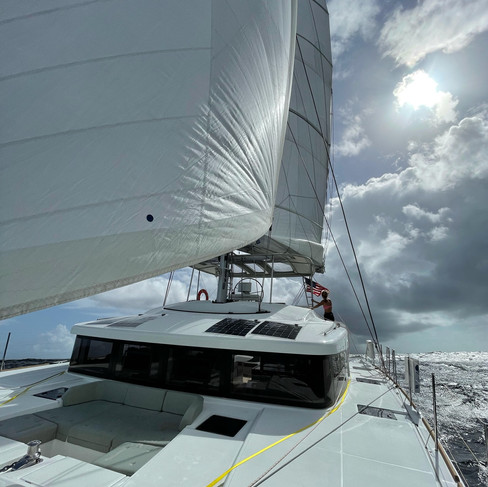Sailing 101: What goes into setting sail?
- Christine
- Jan 17, 2022
- 3 min read
Pilot Book Windy App
Pre-departure
Research destination using pilot books and sailing phone apps
If going to an anchorage, confirm there is an area protected from prevailing/forecasted winds.
If heading to a marina, make/confirm reservation.
Review route, wind conditions, weather and swells and determine best time to set sail
Check battery levels & water levels
Close all hatches
Secure loose items on board
Turn on boat engines and let them warm up for 5 minutes
Megan working the remote windlass to drop anchor at a designated anchorage
Departure (Arrivals are just the opposite actions)
If departing from anchorage:
A crew member at the bow of the boat will lift anchor using remote controlled electric windlass giving useful directional hand signals to skipper on the fly bridge.
Skipper maneuvers boat as needed so the anchor lifts straight up.
Crew member at the bow will secure the bridal (lines that take the pressure off the anchor of the boat) and anchor chain with a shackle to prevent accidental deployment while underway.
If departing from a marina:
Skipper assess immediate wind and sea conditions before backing out of a berth to determine best strategy to avoid colliding with neighboring yachts.
A crew member (or two) will stand at the bow and/or stern of the boat to release the bow and stern lines as directed by the skipper (order determined by skipper).
After boat has safely motored out of the berth, all docking lines and fenders are removed and stored in the bow lockers.

Line being tossed by a Helios crew member to a deck hand on the dock in Grenada.
SAILING
Sailing with the Mainsail and the Jib Helios trade wind sail (Dale's pride & joy)
Sailing Basics
Once safely out of the harbor, away from boat traffic, the skipper will confirm the wind direction and wind speed towards a destination to determine which sail configuration (if any) would be the safest and most efficient.
With a sailboat, we always choose sailing over motoring, any day, if possible .
Sailing is so much more peaceful, relaxing and quiet, but one must always be alert of wind and sea conditions as they can change very quickly.
Motoring is rougher and the motor is a bit noisy. Usually, this is a short-term condition. Motoring is necessary if:
There is not enough wind (less than 5 knots)
There is an issue with the sails.
We're under a time crunch and we are fighting a headwind.
Motor sailing is an option if the winds are weak, and we're not fighting a headwind and we are under a time crunch to get somewhere (always try to arrive to our destination during daylight hours).
There are 3 sails on Helios, but since the tradewind sail converts into a code zero sail, we technically have 4 different sails. These sails can be used alone or in different combinations:
Main sail
Jib (headsail)
Tradewind Sail (headsail with full sun logo)
Code Zero (Tradewind sail folded in half, with half the sun logo)
Our sail configurations depend on the direction and strength of the wind:
If there is a headwind (wind coming towards the bow of the boat)
Sail with the mainsail and a headsail, such as a jib or code zero, at an angle to the wind, but there will be some or a lot of tacking depending on the route chosen. Not a big deal, as our boat is self-tacking, but it will take longer to get to our destination as this is not a direct route.
If there is a tailwind (wind coming towards the stern of the boat)
Sail with mainsail and trade wind sail or code zero headsail. Can also just sail with a trade wind headsail only. There may be some jibing necessary.
Our trade wind sail is absolutely huge and looks like a huge wall of sail in front of the boat and requires some one watching for obstacles or other boats from the galley area or up at the bow of the boat.
For the Atlantic crossing, the trade winds are very favorable to using the trade wind sail.
If the winds are very strong (over 26 knots) or forecasted to be strong, we reef our sails, meaning, we do not put up a full sail. Depending on the strength of the wind, we may reef the mainsail anywhere between 25%-75% of its full surface area and will also follow suit with our jib. If winds are crazy strong, we can drop the jib and/or mainsail.
.png)








Comments